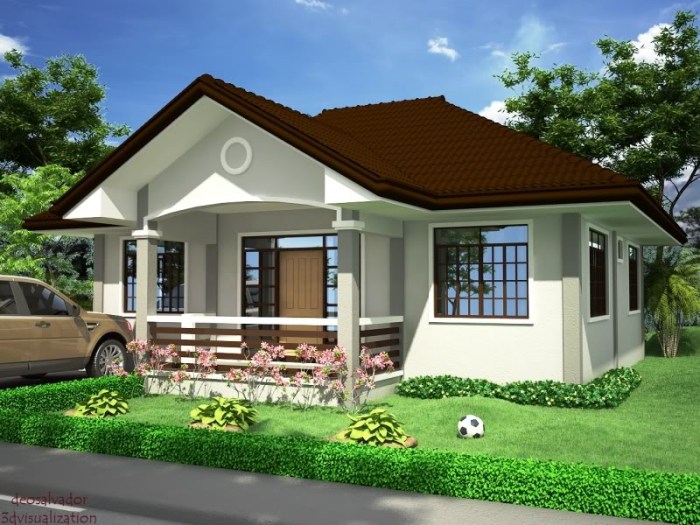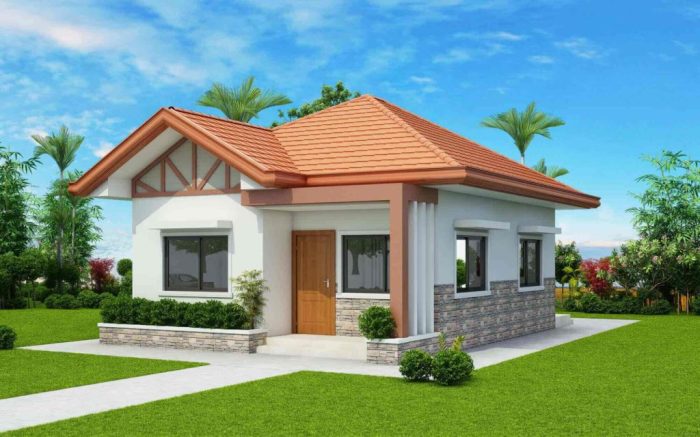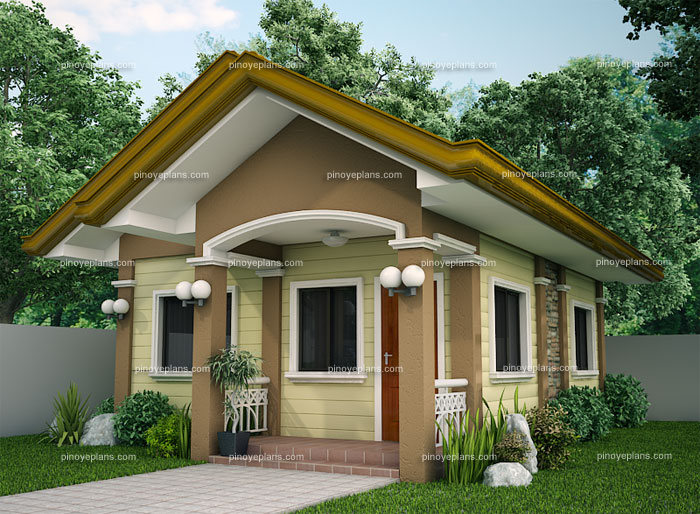Defining “Simple Filipino House Design”

A simple Filipino house design prioritizes functionality and affordability, reflecting the values of resourcefulness and family within Filipino culture. These homes often utilize readily available and cost-effective materials, resulting in smaller footprints compared to more elaborate structures. The architectural style is generally straightforward, emphasizing practicality over ostentatious display.Simple Filipino house designs often incorporate elements that reflect the country’s tropical climate and the needs of its people.
This results in a distinct aesthetic that blends practicality with a sense of homeliness. The cultural significance of these designs lies in their ability to provide comfortable and functional living spaces while adhering to traditional values of community and family.
Common Characteristics of Simple Filipino Homes
Simple Filipino homes often share several key characteristics. These features are not only practical but also reflect deeply ingrained cultural values. The design emphasizes efficient use of space and natural resources, contributing to their overall simplicity and affordability.
- Use of Natural Materials: Many utilize readily available materials like wood, bamboo, and nipa that are both sustainable and relatively inexpensive. The choice of materials often depends on regional availability and traditional building practices.
- Elevated Structure: To protect against flooding and dampness, many homes are built on stilts, a design feature common in many tropical regions, including the Philippines.
- Open-Air Design: To maximize ventilation and allow for natural light, simple Filipino houses often feature open spaces and large windows, helping to regulate the interior temperature in the hot and humid climate.
- Simple Roofing: Gabled or hipped roofs are common, often made of galvanized iron or nipa thatch, depending on budget and local traditions.
- Compact Footprint: The size of the house is typically modest, reflecting the emphasis on practicality and efficient use of resources. The focus is on creating a comfortable and functional space for the family rather than on expansive living areas.
Cultural Significance of Simple Filipino House Designs
The cultural significance of simple Filipino house designs extends beyond mere practicality. These homes reflect deeply held values within Filipino society. The focus on family and community is evident in the design’s emphasis on creating a comfortable and welcoming space for family gatherings and social interactions.
“The simple Filipino house is more than just a dwelling; it is a reflection of our values, our history, and our connection to the land.”
The use of locally sourced materials highlights a respect for nature and a sustainable approach to living, emphasizing resourcefulness and self-reliance, values that are highly valued within Filipino culture. The designs often reflect a deep connection to the land and the community, fostering a sense of belonging and shared identity. The simplicity itself speaks to a value system that prioritizes family, community, and resourcefulness over material wealth and ostentation.
Common Materials Used

The choice of building materials significantly impacts the cost, durability, and environmental footprint of a simple Filipino house. Traditional materials have been used for generations, offering a connection to cultural heritage, while modern options provide advantages in terms of efficiency and longevity. Understanding the properties and implications of each material is crucial for informed decision-making in construction.
Simple Filipino houses traditionally utilize readily available and cost-effective materials. Modern constructions often incorporate a blend of traditional and contemporary materials to balance cost, durability, and aesthetics. This blend reflects the evolving needs and resources available to Filipino homeowners.
Material Properties and Comparison
The table below compares four common building materials used in constructing simple Filipino houses, considering their cost, durability, and environmental impact. Cost estimates are approximate and can vary based on location and market conditions. Durability refers to the material’s resistance to wear and tear, while sustainability considers its environmental impact throughout its lifecycle, from extraction to disposal.
Simple Filipino house designs often prioritize functionality and affordability, reflecting a strong connection to the local environment. However, as needs evolve, some families opt for more expansive designs, such as a three storey house design , which allows for greater space and vertical living. Ultimately, the ideal design depends on individual family requirements, but even larger homes can still incorporate elements of simple Filipino architecture for a cohesive and comfortable living space.
| Material | Cost (Approximate) | Durability | Sustainability |
|---|---|---|---|
| Bamboo | Low to Moderate | Moderate (susceptible to pests and weather) | High (renewable, biodegradable) |
| Wood (e.g., Narra, Apitong) | Moderate to High | High (depending on wood type and treatment) | Moderate (sustainable sourcing crucial) |
| Concrete | Moderate to High | High (durable and resistant to weather) | Low (high embodied carbon, non-renewable resources) |
| Light Steel Framing (LSF) | Moderate to High | High (resistant to pests, fire, and earthquakes) | Moderate (recyclable, but manufacturing has an impact) |
Adapting to Modern Needs

Traditional simple Filipino house designs, with their inherent charm and practicality, can be seamlessly adapted to meet the evolving needs of modern Filipino families. The key lies in intelligently integrating modern amenities and sustainable practices without sacrificing the core aesthetic and functionality that define these homes. This involves a thoughtful approach to space planning, material selection, and technological integration.The beauty of a simple Filipino house design lies in its adaptability.
While maintaining the characteristic open-air spaces and natural ventilation, modern conveniences can be incorporated to enhance comfort and functionality. This approach ensures that the home remains both aesthetically pleasing and highly functional for contemporary living.
Incorporating Modern Amenities
Modern Filipino families require spaces that cater to various needs, from home offices to entertainment areas. Traditional designs can be easily modified to accommodate these. For instance, a previously unused corner can be transformed into a compact home office, incorporating built-in shelving and a workspace. Similarly, a small, covered patio can be redesigned as an outdoor entertainment area, perfect for family gatherings.
The integration of these modern amenities should be done subtly, maintaining the overall simplicity of the design. A well-placed, modern light fixture or a stylish, yet functional, built-in media console can enhance the space without disrupting the traditional aesthetic.
Energy Efficiency and Sustainable Practices
Integrating energy-efficient and sustainable practices is crucial in adapting simple Filipino house designs for modern living. The use of natural light and ventilation, inherent in traditional designs, is already a significant step towards energy conservation. This can be further enhanced through the strategic placement of windows and the use of energy-efficient lighting fixtures and appliances. The incorporation of solar panels for water heating or even electricity generation is another sustainable option that complements the design’s inherent simplicity.
Furthermore, the use of locally sourced, sustainable building materials like bamboo and sustainably harvested timber can reduce the environmental impact of construction and promote the use of locally available resources. For example, a family might opt for bamboo flooring instead of concrete, maintaining a natural aesthetic while reducing the carbon footprint of the house.
Modernizing Materials While Maintaining Tradition, Simple filipino house design
While traditional materials like nipa and bamboo remain popular choices, modern alternatives can offer enhanced durability and longevity. For example, treated bamboo can withstand the elements better than untreated bamboo, extending the lifespan of the structure. Similarly, using modern, sustainable alternatives to nipa that offer improved weather resistance can maintain the traditional aesthetic while enhancing the home’s durability.
The incorporation of these materials allows for a blend of tradition and modernity, ensuring the home is both aesthetically pleasing and resilient.
Helpful Answers: Simple Filipino House Design
What are some common misconceptions about simple Filipino house designs?
A common misconception is that “simple” equates to “basic” or lacking in style. Simple Filipino house designs can be both aesthetically pleasing and highly functional, incorporating modern amenities while maintaining a traditional charm.
How can I find a reliable contractor for building a simple Filipino house?
Seek recommendations from friends, family, or community members. Check online reviews and verify licenses and insurance. It’s also advisable to interview multiple contractors and compare bids before making a decision.
Are there any government programs or incentives available for building affordable Filipino homes?
This varies depending on location and current government initiatives. Research local housing programs and consult with relevant government agencies for the most up-to-date information.
What are some ways to make a simple Filipino house design more energy-efficient?
Incorporate natural ventilation, utilize energy-efficient lighting and appliances, and consider the use of solar panels for renewable energy. Proper insulation can also significantly reduce energy consumption.
